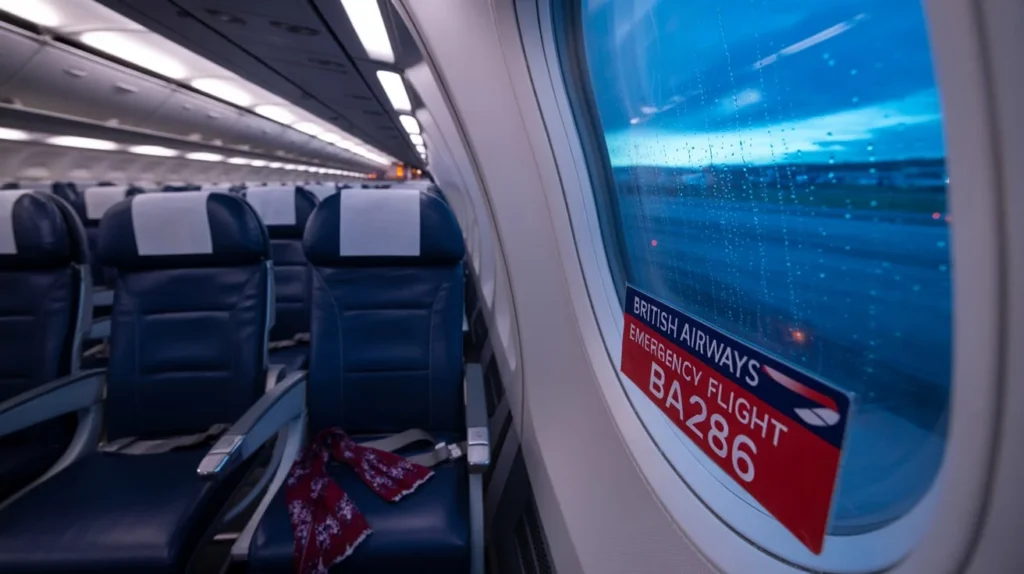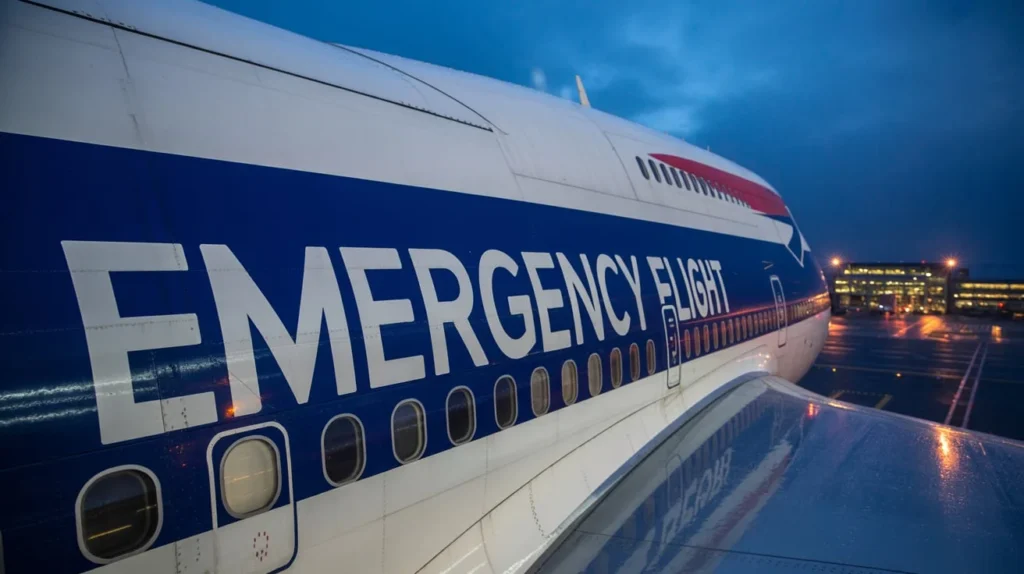On May 26, 2025, British Airways Flight BA286, an Airbus A380-841 (registration G-XLEG), encountered a significant in-flight emergency while en route from San Francisco International Airport (SFO) to London Heathrow Airport (LHR). Approximately four hours into the transatlantic journey, the flight crew declared a general emergency by squawking 7700, signalling a critical situation requiring immediate attention.
The aircraft, cruising at 41,000 feet over Scotland, was diverted to London Heathrow, where it landed safely on runway 27L at 13:39 BST. The aircraft was subsequently parked at stand C56 at 13:48 BST.
This incident underscores the complexities of modern aviation and the critical importance of effective emergency response protocols. It also highlights the resilience and professionalism of airline crews and ground staff in managing unforeseen crises.
Flight Overview and Route Details
British Airways Flight BA286 operates as a daily transatlantic service between San Francisco and London Heathrow. The flight typically departs SFO in the evening and arrives in London the following morning, covering a distance of approximately 5,350 miles (8,600 kilometers). The Airbus A380-841, known for its spacious cabins and advanced technology, serves as the aircraft for this route.
On May 26, 2025, the flight departed SFO at 19:33 PDT. After crossing the Atlantic and cruising at 41,000 feet over Scotland, the crew declared an emergency. The decision to divert to London Heathrow was made to ensure the safety of all passengers and crew members on board.
Timeline of the Emergency Incident
- 19:33 PDT (May 26, 2025): Flight BA286 departs San Francisco International Airport.
- Approximately 23:30 PDT: The aircraft crosses the Atlantic Ocean, nearing the United Kingdom.
- Around 04:30 BST (May 27, 2025): The flight crew declares a general emergency by squawking 7700, indicating a critical situation.
- 13:39 BST: The Airbus A380-841 lands safely on runway 27L at London Heathrow Airport.
- 13:48 BST: The aircraft is parked at stand C56, and emergency services begin their assessment.
Causes of the Emergency
The emergency primarily occurred due to a medical incident involving a passenger on board. Although the airline has not publicly disclosed specific details about the medical issue, such situations are relatively common on long-haul flights. Consequently, the crew decided to divert to London Heathrow to ensure the passenger could receive immediate medical attention upon landing.
It’s important to note that in-flight medical emergencies can arise from various factors, including pre-existing health conditions, complications during the flight, or unforeseen medical events. Airlines are equipped with trained medical personnel and emergency protocols to handle such situations effectively.
Pilot and Crew Response

Upon recognizing the severity of the medical emergency, the flight crew promptly declared a general emergency by squawking 7700. This action alerted air traffic control to the critical situation, allowing for expedited handling of the flight’s needs. The crew’s decision to divert to London Heathrow was a precautionary measure to ensure the safety and well-being of all individuals on board.
The professionalism and quick thinking of the flight crew were instrumental in managing the situation. Their adherence to established emergency protocols and effective communication with air traffic control and ground services ensured a safe and efficient resolution to the incident.
Passenger Experiences and Reactions
Passengers aboard Flight BA286 experienced a range of emotions during the emergency. Many were unaware of the severity of the situation until after the safe landing. Upon arrival at London Heathrow, passengers were deplaned and provided with assistance as needed.
Although the incident caused some delays, British Airways promptly accommodated all passengers and rebooked them on subsequent flights as needed. The airline’s customer service team worked diligently to address any concerns and provide support to affected travellers.
Emergency Landing Procedures and Airport Response
Upon receiving the squawk 7700 signal from Flight BA286, London Heathrow Airport promptly activated its emergency response protocols. Fire and rescue services, medical teams, and ground staff were on standby to assist upon landing.
The aircraft landed safely on runway 27L, and emergency services conducted a thorough assessment of the situation. The airport’s emergency teams responded swiftly and in a coordinated manner, ensuring the safety and well-being of everyone involved.
Impact on British Airways Operations
The emergency landing of Flight BA286 had minimal impact on British Airways’ operations. The airline’s contingency plans were effectively implemented, allowing for the swift accommodation and rebooking of affected passengers.
British Airways’ commitment to passenger safety and operational efficiency was evident throughout the incident. The airline’s ability to manage the situation effectively reflects its dedication to maintaining high standards of service and safety.
Financial and Operational Consequences
While the emergency landing of Flight BA286 required immediate attention and resources, the financial and operational consequences were limited. The airline’s established emergency protocols and contingency plans mitigated potential disruptions.
British Airways’ proactive approach ensured the incident did not cause major financial losses or operational setbacks. The airline’s swift response and effective management underscored its resilience and commitment to high standards of service.
Lessons for the Aviation Industry
The incident involving Flight BA286 highlights several key lessons for the aviation industry:
- Importance of Crew Training: Ongoing training ensures that flight crews are prepared to handle a wide range of emergencies effectively.
- Effective Communication: Clear and timely communication between flight crews, air traffic control, and ground services is essential in managing emergencies.
- Passenger Safety Protocols: Airlines must have robust protocols in place to ensure the safety and well-being of passengers during in-flight emergencies.
- Contingency Planning: Developing and regularly updating contingency plans allows airlines to respond swiftly and effectively to unforeseen situations.
By incorporating these lessons, the aviation industry can enhance its preparedness and response to emergencies, further ensuring the safety and confidence of passengers.
Safety Protocols and Regulatory Compliance
The handling of the emergency aboard Flight BA286 adhered to established safety protocols and regulatory requirements. The flight crew’s decision to declare a general emergency and divert to London Heathrow was in line with standard procedures for managing in-flight medical emergencies.
Airlines are subject to stringent regulations set forth by aviation authorities, including the International Civil Aviation Organization (ICAO) and national regulatory bodies. These regulations mandate comprehensive training for flight crews, the implementation of safety protocols, and the maintenance of equipment to ensure passenger safety.
The adherence to these regulations during the BA286 incident underscores the importance of compliance in maintaining high safety standards within the aviation industry.
Case Studies of Similar Flight Emergencies
The aviation industry has witnessed several incidents where in-flight medical emergencies led to diversions and emergency landings. For instance, British Airways Flight 2276 experienced an uncontained engine failure during takeoff from Las Vegas-McCarran International Airport in 2015. The crew’s prompt response and adherence to emergency procedures ensured the safety of all 170 occupants .
These case studies highlight the critical role of well-trained crews and established emergency protocols in managing unforeseen situations effectively.
Conclusion and Takeaways
The emergency incident involving British Airways Flight BA286 serves as a testament to the professionalism and preparedness of airline crews and ground staff in handling in-flight emergencies. The swift and coordinated response ensured the safety of all individuals on board and minimized operational disruptions.
Key takeaways from the incident include the importance of ongoing crew training, effective communication, robust passenger safety protocols, and comprehensive contingency planning. By learning from such incidents, the aviation industry can continue to enhance its safety standards and maintain passenger confidence.

